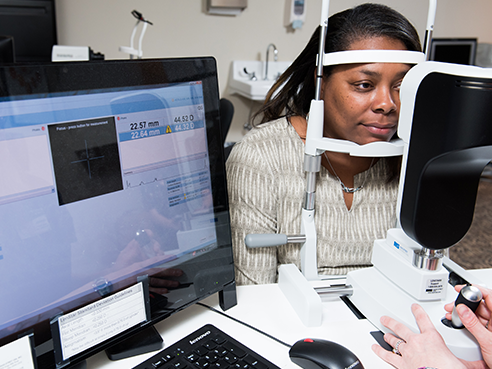 Complications of diabetes can lead to blindness, yet only 29.9 percent of diabetic patients studied adhered to recommendations to have an eye examination.The prevalence of Type 1 and Type 2 diabetes in the United States is 9.3 percent and expected to increase, along with complications associated with diabetes that include diabetic retinopathy, the leading cause of new cases of blindness among adults ages 20 to 74 in the United States.
Complications of diabetes can lead to blindness, yet only 29.9 percent of diabetic patients studied adhered to recommendations to have an eye examination.The prevalence of Type 1 and Type 2 diabetes in the United States is 9.3 percent and expected to increase, along with complications associated with diabetes that include diabetic retinopathy, the leading cause of new cases of blindness among adults ages 20 to 74 in the United States.
Yet many patients do not adhere to their physicians’ eye care recommendations.
University of Alabama at Birmingham researchers Cynthia Owsley, Ph.D., the Nathan E. Miles Chair of Ophthalmology in the UAB Department of Ophthalmology, and UAB School of Medicine student Zachary Keenum are trying to find answers as to the extent county clinic patients with diabetes in a DR screening program adhere to the timetable of recommended follow-up eye examinations.
“The public health success of DR screening programs depends on patients’ adherence to the timetable of follow-up eye care,” the report stated. “African-Americans are among those at highest risk for DR and have one of the lowest rates of eye care use.”
African-Americans are at higher risk for the ocular complications of diabetes than are other segments of the population. Some research has suggested that the quality of their medical care for diabetes is lower than for other groups. African-Americans’ lower rates of eye care are believed to stem from less access and more barriers to care, fewer eye care providers with practices situated in their communities, and a lack of awareness of their high-risk status for vision loss and how routine preventive care could reduce that risk.
Routine dilated comprehensive eye examination remains a cornerstone in the early detection of DR, Owsley says. It creates the opportunity for early intervention and management.
The American Diabetes Association and the American Academy of Ophthalmology Retina Panel recommend routine, annual dilated eye examination for persons with diabetes, beginning five years after diagnosis for Type 1 diabetes and at the time of diagnosis, and annually thereafter for Type 2 diabetes. The study found that an estimated two-thirds of individuals with self-reported diabetes receive an annual dilated eye examination, and those annual use estimates are even lower among African-Americans.“Many times (in diabetic patients), when the blood sugar is not well-controlled, it can cause the aberrant growth of blood vessels and other changes in the eye," Owsley said. "If the glucose is not well controlled in the background stage, it could cause blindness.”
For the study, screenings were performed at Cooper Green Mercy Health Services’ internal medicine clinic in Birmingham. Data from the Jefferson County Health System’s administrative database pertaining to eye care utilization for the patients screened were obtained from January 2012 through May 2015.
When the follow-up eye care utilization data were examined, only 29.9 percent of patients adhered to recommendations to have an eye examination within indicated time frames, even though cost and accessibility were minimized as barriers. Two years after the initial screening, 50.9 percent still had not undergone an eye examination. These data suggest that the DR screening program is unlikely to meet its public health goals for adherence to eye care recommendations since many patients do not seek the recommended follow-up care.
Owsley says strategies for developing and implementing effective education at DR screenings should be carried out as next steps.
“The education would focus on communicating the importance of seeking the eye care that is recommended following the screening, and also on communicating how to avoid barriers to care.”
The study, published in JAMA Ophthalmology, was funded by the Centers for Disease Control and Prevention.